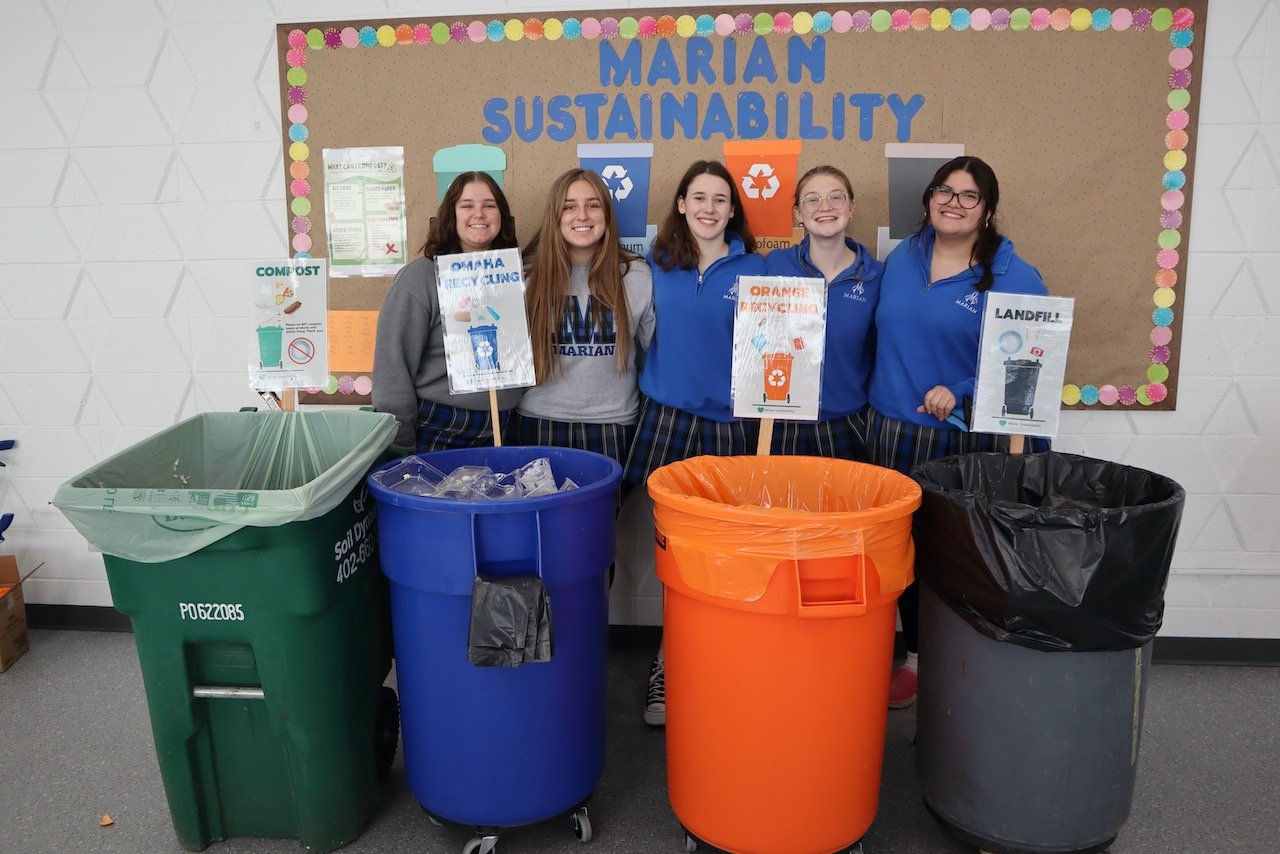How an Omaha High School Created a "Zero Waste to Landfill" Lunch Program
Marian High School just reached its lunchroom “zero waste to landfill” goal. Read on to find out how they did it, how other schools are on the same path, and a model of how more can do it.
The largest source of trash at most schools comes from the lunchroom. But for many, they are making it the least.
“We’re back to pre-pandemic levels of schools participating in our lunchroom composting program,” said Brent Crampton, Director of Partnerships at Hillside Solutions.
Over 25 schools in the Greater Omaha area are now participating. On any given school day, around 12,000 students are separating their food and napkins for composting.
This includes Nebraska’s two largest high schools, Omaha South High School and Central High School. “After just one week, it was incredible to witness Central High School going from 78 bags of trash a day in its lunch rooms down to 8,” said Brent.
Watch this video to see what happened after the first week of composting at Central High School …
Building on that momentum, we have more great news to share: Marian High School just achieved its “zero waste to landfill” goal.
According to Aleecia Cotton and Nick Miller, moderators of Marian’s Sustainability Club and Marian teachers, Marian is now sending less than 10% of its lunchroom waste to the landfill.
For context, to be considered having a “zero waste to landfill” program, facility, or home, 90% or more of the waste generated is either recycled, composted, reduced, or prevented from being used in the first place. Marian joins the ranks with Creighton Prep High School, which achieved this goal in 2019. And Duchesne Academy, which reached its zero waste goals for its entire building in 2022.
“When we first started the lunchroom recycling and composting program at Marian in August of 2019, we recorded an 80% landfill diversion during the first week,” said Brent.
“That’s better than average. But Marian was using a lot of compostable serveware. The supply chain for that was still pretty young and very unreliable.”
With bowls and cups changing from plastic to compostable any given week, this caused a lot of confusion at the bin. “A mix of plastic and other trash was a common sight in the compost bin. And as the student body changed and the pandemic happened, I thought Marian might call it quits,” said Brent.
But in walked the “Compost Queens,” and something miraculous happened.
To get the inside scoop, we interviewed Aleecia, one of the drivers behind Marian’s eco-movement. Read on for how they did it and how your school can do the same …
Hillside: You had a wonderful comeback. How’d it happen?
Aleecia Cotton: As things settled back into a more normal routine in 2021-2022, we fortunately found a dedicated group of students. They were determined to change the culture of sustainability at Marian. Our principal, Mrs. Sullivan, began to refer to them as the “Compost Queens,” and the name stuck.
We started small. A 5-gallon bucket was placed next to the garbage cans. We helped reteach the students. And day by day, we saw progress.
So we brainstormed where to go next. We collaborated with our awesome lunch providers to use more compostable and recyclable items. Then we began implementing strategies to get students back on board.
What was your strategy for reducing landfill and increasing recycling and composting?
It starts with our wonderful student-led Sustainability Club. They helped create and sustain the culture of sustainability and established our zero-waste goal. More on that, but in the eating spaces, we have two zero-waste stations, each with four bins. They are color-coded according to national standards The green bin is for compost, blue is for single-stream recycling, orange is for Hefty Renew recycling, and gray is for landfill items. We use signage with commonly tossed items attached to each bin. The “Compost Queens” monitor the bins to help students sort items into the correct place.
You’re using a mix of single-use items. Tell us what that is and how students are doing with separating them at the stations.
Most days, students are served lunches on compostable plates and trays. A few items still go to the landfill, particularly the bowls and condiment packets. Salads, wraps, yogurt, fruit, and ice cream are all served in recyclable containers, and First Star’s Hefty Renew recycling program allows us to recycle flimsy plastics, including plastic utensils, and styrofoam boxes and cups. Teaching students which items belong in which can is an ongoing process, but we’re seeing great progress.
How do you maintain the success of the program as your student body changes?
The Sustainability Club students created a video explaining the “why” behind compost and recycling and the process the students would follow. During the first week of school, the students watch the video in their homeroom. To bring it to life, we came up with a competitive game they play in the gym.
We set up a mock lunch table with all of the items students typically toss. On the other side of the gym, we placed our four color-coded bins. After introducing and applauding our “Compost Queens,” we give a quick lesson on which items belong in which can. Then we run a stopwatch on the scoreboard as a small group of volunteers sprint to move the items on the table to the correct cans across the gym.
After round one, each grade had an opportunity to debrief, discuss strategy, and try a second time. Doing this really helps engrain the lesson. The competitiveness also creates a lot of enthusiasm. And in the daily practice, we’ve observed students helping each other out when they toss items to help the process go quicker.
What role has faith played in this effort? Why does it seem like there’s such a great pair between Catholicism and zero-waste practices?
There are a bunch of Church teachings on this subject. But the eco-movement got a big push within Catholicism in 2015 when Pope Francis issued the Laudato si’, which is his encyclical on care for our common home. It goes like this …
"A true ecological approach always becomes a social approach; it must integrate questions of justice in debates on the environment, so as to hear both the cry of the earth and the cry of the poor. . . . Everything is connected. Concern for the environment thus needs to be joined to a sincere love for our fellow human beings and an unwavering commitment to resolving the problems of society." (Pope Francis, On Care for Our Common Home [Laudato Si'], nos. 49, 91).
It also helps that Marian has a deeply rooted commitment to incorporating values into our school experience. Marian's core values are Marian identity, compassion, spirituality, empowerment, service, and community. Students are taught to bring God’s compassionate presence to their communities, identify and act on injustice, see God in all things, use their strengths and abilities for positive impact, accept responsibility for their actions, demonstrate a commitment to service, and work collaboratively.
We found that having these core values naturally feeds into our sustainability efforts.
What changes in people’s lives have you seen?
It’s been great to see the lunch-room practice extend beyond the walls of our school. Several Marian teachers are enthusiastic participants in Hillside’s residential Compost Club program. Subsequently, the daughters of those teachers are compost experts. And we’ve been surprised by how many students tell us they compost at home or participate in the Hefty Renew program. We even had a Sustainability Club member complete her job shadow at First Star, which is the recycling facility that processes Hefty Renew bags.
What are the next eco-steps for Marian?
We’ve expanded the composting and Hefty Renew program into other parts of the building, but since the spirit of zero waste is more than just recycling and composting, we’re exploring opportunities to take it to the next level. This includes reducing our school’s overall carbon footprint and teaching about the importance of reusing and reducing.
For example, we’re hosting a coat driver this winter, which exemplifies the value of reuse. We’re pursuing opportunities to integrate sustainability into Marian courses, update our school’s energy profile, help with campus cleanup efforts, and facilitate student-to-student textbook transfers at the end of each school year. Even thinking about how we can reduce the pollution from cars during the drop-off and pickup process.
There’s just so many opportunities to explore. But we’re really proud of everything our students have accomplished. We’ll be using that momentum to fuel future efforts.



